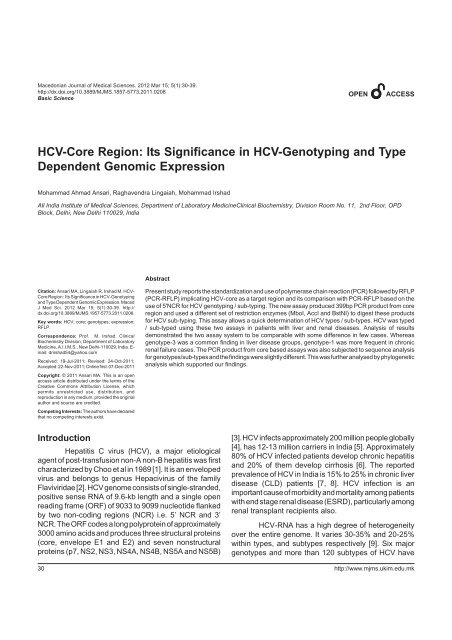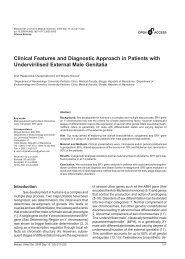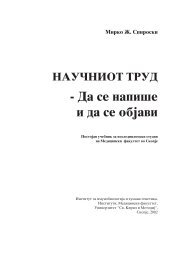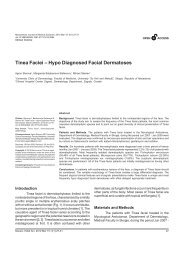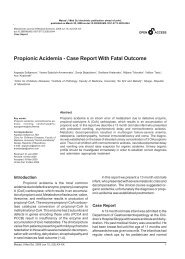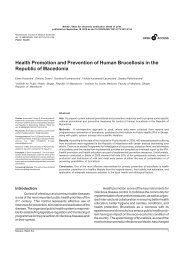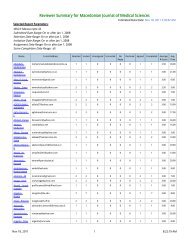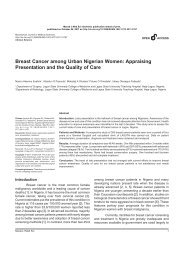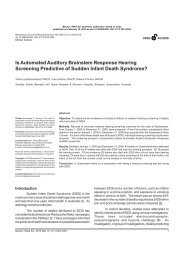HCV-Core Region: Its Significance in HCV-Genotyping and Type ...
HCV-Core Region: Its Significance in HCV-Genotyping and Type ...
HCV-Core Region: Its Significance in HCV-Genotyping and Type ...
You also want an ePaper? Increase the reach of your titles
YUMPU automatically turns print PDFs into web optimized ePapers that Google loves.
Basic Science<br />
Macedonian Journal of Medical Sciences. 2012 Mar 15; 5(1):30-39.<br />
http://dx.doi.org/10.3889/MJMS.1857-5773.2011.0208<br />
Basic Science<br />
OPENACCESS<br />
<strong>HCV</strong>-<strong>Core</strong> <strong>Region</strong>: <strong>Its</strong> <strong>Significance</strong> <strong>in</strong> <strong>HCV</strong>-Genotyp<strong>in</strong>g <strong>and</strong> <strong>Type</strong><br />
Dependent Genomic Expression<br />
Mohammad Ahmad Ansari, Raghavendra L<strong>in</strong>gaiah, Mohammad Irshad<br />
All India Institute of Medical Sciences, Department of Laboratory Medic<strong>in</strong>eCl<strong>in</strong>ical Biochemistry, Division Room No. 11, 2nd Floor, OPD<br />
Block, Delhi, New Delhi 110029, India<br />
Abstract<br />
Citation: Ansari MA, L<strong>in</strong>gaiah R, Irshad M. <strong>HCV</strong>-<br />
<strong>Core</strong> <strong>Region</strong>: <strong>Its</strong> <strong>Significance</strong> <strong>in</strong> <strong>HCV</strong>-Genotyp<strong>in</strong>g<br />
<strong>and</strong> <strong>Type</strong> Dependent Genomic Expression. Maced<br />
J Med Sci. 2012 Mar 15; 5(1):30-39. http://<br />
dx.doi.org/10.3889/MJMS.1957-5773.2011.0208.<br />
Key words: <strong>HCV</strong>; core; genotypes; expression;<br />
RFLP.<br />
Correspondence: Prof. M. Irshad. Cl<strong>in</strong>ical<br />
Biochemistry Division, Department of Laboratory<br />
Medic<strong>in</strong>e, A.I.I.M.S., New Delhi-110029, India. E-<br />
mail: drirshad54@yahoo.com<br />
Received: 19-Jul-2011; Revised: 24-Oct-2011;<br />
Accepted: 22-Nov-2011; Onl<strong>in</strong>e first: 07-Dec-2011<br />
Copyright: © 2011 Ansari MA. This is an open<br />
access article distributed under the terms of the<br />
Creative Commons Attribution License, which<br />
permits unrestricted use, distribution, <strong>and</strong><br />
reproduction <strong>in</strong> any medium, provided the orig<strong>in</strong>al<br />
author <strong>and</strong> source are credited.<br />
Compet<strong>in</strong>g Interests: The authors have declared<br />
that no compet<strong>in</strong>g <strong>in</strong>terests exist.<br />
Present study reports the st<strong>and</strong>ardization <strong>and</strong> use of polymerase cha<strong>in</strong> reaction (PCR) followed by RFLP<br />
(PCR-RFLP) implicat<strong>in</strong>g <strong>HCV</strong>-core as a target region <strong>and</strong> its comparison with PCR-RFLP based on the<br />
use of 5'NCR for <strong>HCV</strong> genotyp<strong>in</strong>g / sub-typ<strong>in</strong>g. The new assay produced 399bp PCR product from core<br />
region <strong>and</strong> used a different set of restriction enzymes (MboI, AccI <strong>and</strong> BstNI) to digest these products<br />
for <strong>HCV</strong> sub-typ<strong>in</strong>g. This assay allows a quick determ<strong>in</strong>ation of <strong>HCV</strong> types / sub-types. <strong>HCV</strong> was typed<br />
/ sub-typed us<strong>in</strong>g these two assays <strong>in</strong> patients with liver <strong>and</strong> renal diseases. Analysis of results<br />
demonstrated the two assay system to be comparable with some difference <strong>in</strong> few cases. Whereas<br />
genotype-3 was a common f<strong>in</strong>d<strong>in</strong>g <strong>in</strong> liver disease groups, genotype-1 was more frequent <strong>in</strong> chronic<br />
renal failure cases. The PCR product from core based assays was also subjected to sequence analysis<br />
for genotypes/sub-types <strong>and</strong> the f<strong>in</strong>d<strong>in</strong>gs were slightly different. This was further analysed by phylogenetic<br />
analysis which supported our f<strong>in</strong>d<strong>in</strong>gs.<br />
Introduction<br />
Hepatitis C virus (<strong>HCV</strong>), a major etiological<br />
agent of post-transfusion non-A non-B hepatitis was first<br />
characterized by Choo et al <strong>in</strong> 1989 [1]. It is an enveloped<br />
virus <strong>and</strong> belongs to genus Hepacivirus of the family<br />
Flaviviridae [2]. <strong>HCV</strong> genome consists of s<strong>in</strong>gle-str<strong>and</strong>ed,<br />
positive sense RNA of 9.6-kb length <strong>and</strong> a s<strong>in</strong>gle open<br />
read<strong>in</strong>g frame (ORF) of 9033 to 9099 nucleotide flanked<br />
by two non-cod<strong>in</strong>g regions (NCR) i.e. 5’ NCR <strong>and</strong> 3’<br />
NCR. The ORF codes a long polyprote<strong>in</strong> of approximately<br />
3000 am<strong>in</strong>o acids <strong>and</strong> produces three structural prote<strong>in</strong>s<br />
(core, envelope E1 <strong>and</strong> E2) <strong>and</strong> seven nonstructural<br />
prote<strong>in</strong>s (p7, NS2, NS3, NS4A, NS4B, NS5A <strong>and</strong> NS5B)<br />
30<br />
[3]. <strong>HCV</strong> <strong>in</strong>fects approximately 200 million people globally<br />
[4], has 12-13 million carriers <strong>in</strong> India [5]. Approximately<br />
80% of <strong>HCV</strong> <strong>in</strong>fected patients develop chronic hepatitis<br />
<strong>and</strong> 20% of them develop cirrhosis [6]. The reported<br />
prevalence of <strong>HCV</strong> <strong>in</strong> India is 15% to 25% <strong>in</strong> chronic liver<br />
disease (CLD) patients [7, 8]. <strong>HCV</strong> <strong>in</strong>fection is an<br />
important cause of morbidity <strong>and</strong> mortality among patients<br />
with end stage renal disease (ESRD), particularly among<br />
renal transplant recipients also.<br />
<strong>HCV</strong>-RNA has a high degree of heterogeneity<br />
over the entire genome. It varies 30-35% <strong>and</strong> 20-25%<br />
with<strong>in</strong> types, <strong>and</strong> subtypes respectively [9]. Six major<br />
genotypes <strong>and</strong> more than 120 subtypes of <strong>HCV</strong> have<br />
http://www.mjms.ukim.edu.mk
Ansari et al. <strong>HCV</strong>-core <strong>in</strong> genotyp<strong>in</strong>g<br />
been characterized [10]. These <strong>HCV</strong> genotypes have<br />
dist<strong>in</strong>ct geographic distribution worldwide. Genotypes 1,<br />
2 <strong>and</strong> 3 are widely distributed while other genotypes are<br />
much more restricted to certa<strong>in</strong> geographical areas. In<br />
India, genotype 3 is reported to be the most prevalent,<br />
followed by genotype 1 [11, 12]. These genotypes of<br />
<strong>HCV</strong> have important epidemiological implications. The<br />
duration <strong>and</strong> response to <strong>in</strong>terferon therapy <strong>in</strong> <strong>HCV</strong><br />
<strong>in</strong>fected patients depends <strong>and</strong> varies accord<strong>in</strong>g to <strong>HCV</strong><br />
genotypes [13, 14].<br />
Real-time PCR <strong>and</strong> nucleotide sequenc<strong>in</strong>g are<br />
the most reliable methods for <strong>HCV</strong> genotyp<strong>in</strong>g <strong>and</strong> often<br />
used as gold st<strong>and</strong>ard method [15]. Sequenc<strong>in</strong>g is a<br />
complex <strong>and</strong> time consum<strong>in</strong>g step. Other genotyp<strong>in</strong>g<br />
methods <strong>in</strong>clude restriction fragment length<br />
polymorphism (RFLP) [16, 17], type-specific polymerase<br />
cha<strong>in</strong> reaction (PCR) [18], hybridization based l<strong>in</strong>e probe<br />
assay (LiPA) [19] <strong>and</strong> serotyp<strong>in</strong>g us<strong>in</strong>g type-specific<br />
peptides of the <strong>HCV</strong> polyprote<strong>in</strong> [20]. Although these<br />
methods are sensitive, they can identify only fewer<br />
subtypes <strong>and</strong> cannot differentiate subtypes accurately<br />
<strong>in</strong> most of the cases.<br />
350 bases long fragment of 5’ non-cod<strong>in</strong>g region<br />
(5’ NCR), is the most conserved part (~95%) of <strong>HCV</strong><br />
genomes <strong>and</strong> conta<strong>in</strong> genotype specific motifs [21].<br />
However, it has been analyzed that this region alone<br />
cannot accurately dist<strong>in</strong>guish genotype 1 <strong>and</strong> 6 <strong>and</strong><br />
subtypes of genotype 1 [22, 23]. The nearby core region<br />
is also well conserved <strong>and</strong> has 81 to 88% nucleotide<br />
sequence similarity [21]. Recent reports <strong>in</strong>dicate that<br />
sequence <strong>in</strong>formation of core region is sufficient to<br />
differentiate all genotypes <strong>and</strong> several subtypes [24].<br />
Thus, present study is an attempt to develop a<br />
method for <strong>HCV</strong> typ<strong>in</strong>g based on a newly designed RT-<br />
PCR, followed by restriction fragment length<br />
polymorphism (RFLP) analysis us<strong>in</strong>g <strong>HCV</strong>-core as the<br />
target region. This newly developed assay, simultaneous<br />
with exist<strong>in</strong>g assay based on PCR-RFLP of 5’ NCR<br />
region, was used <strong>in</strong> patients with liver failure <strong>and</strong> renal<br />
diseases for <strong>HCV</strong>-genotyp<strong>in</strong>g <strong>and</strong> a comparison was<br />
made. The procedure allows a quick identification of<br />
nearly all major types <strong>and</strong> subtypes of <strong>HCV</strong>, <strong>and</strong> is more<br />
accurate <strong>and</strong> easier to perform than similar methods so<br />
far described. Present report also describes the relation<br />
of <strong>HCV</strong>-core expression as <strong>in</strong>dicated by the presence of<br />
<strong>HCV</strong>-core prote<strong>in</strong> <strong>in</strong> serum, with viral types / sub-types<br />
<strong>in</strong> different disease groups.<br />
Maced J Med Sci. 2012 Mar 15; 5(1):30-39.<br />
Material <strong>and</strong> Methods<br />
Patients <strong>and</strong> blood samples<br />
A total number of 63 patients compris<strong>in</strong>g 14<br />
patients with chronic liver diseases (CLD), 4 patients<br />
with cirrhosis, 12 patients with hepatocellular carc<strong>in</strong>oma<br />
(HCC) <strong>and</strong> 17 patients with chronic renal failure (CRF)<br />
before dialysis were <strong>in</strong>cluded <strong>in</strong> this study plan. 16 of<br />
these were excluded for genotyp<strong>in</strong>g as these could not<br />
be found positive for <strong>HCV</strong>-RNA on conventional PCR<br />
due to low viral load. The above case number is based<br />
on the statistical analysis us<strong>in</strong>g SPSS Statistics 16.0. All<br />
these patients were <strong>HCV</strong> positive as detected <strong>and</strong><br />
confirmed by Real Time PCR.<br />
The venous blood (6-10 mL) was drawn <strong>and</strong><br />
transferred <strong>in</strong> pla<strong>in</strong> tubes without anticoagulant from<br />
<strong>HCV</strong> positive patients diagnosed with chronic liver<br />
diseases (CLD), cirrhosis of liver, Hepatocellular<br />
carc<strong>in</strong>oma (HCC) <strong>and</strong> chronic renal failure (CRF). The<br />
patients were <strong>in</strong> adult age group <strong>and</strong> represented both<br />
the sexes. They attended either Out Patient Department<br />
or admitted to the Gastroenterology Unit/Haemodialysis<br />
Unit of All India Institute of Medical Sciences, New Delhi.<br />
Blood samples were collected after gett<strong>in</strong>g consent from<br />
the patients. These patients were evaluated cl<strong>in</strong>ically<br />
<strong>and</strong> biochemically <strong>and</strong> their sera were tested for various<br />
hepatitis markers (<strong>HCV</strong>-antibody <strong>and</strong> <strong>HCV</strong>-core antigen)<br />
<strong>and</strong> test parameters <strong>in</strong>clud<strong>in</strong>g liver function tests <strong>and</strong><br />
hemogram. The diagnosis of different types of diseases<br />
was based on accepted cl<strong>in</strong>ical, biochemical <strong>and</strong><br />
histological criteria as outl<strong>in</strong>ed elsewhere [25]. The<br />
study protocol was approved by the Institutional Ethical<br />
Committee.<br />
<strong>HCV</strong>- RNA extraction <strong>and</strong> cDNA<br />
synthesis<br />
<strong>HCV</strong>-RNA was extracted from 200 μL serum<br />
sample us<strong>in</strong>g High Pure Viral Nucleic Acid Kit (total<br />
nucleic acid isolation Kit-Roche Applied Science,<br />
Germany) follow<strong>in</strong>g manufacturer’s <strong>in</strong>structions. RNA<br />
was eluted <strong>in</strong>to 50 μL Elution buffer, aliquoted <strong>and</strong> stored<br />
at -70°C. The extracted RNA was denatured at 65°C for<br />
10 m<strong>in</strong> before the reverse transcription step. cDNA was<br />
synthesized by cDNA synthesis kit (Transcriptor High<br />
Fidelity cDNA Synthesis Kit-Roche, Germany) at 42°C<br />
for 30 m<strong>in</strong>utes us<strong>in</strong>g 60ìM of r<strong>and</strong>om hexamer primer.<br />
<strong>HCV</strong>- RNA detection on real time PCR<br />
Patient sera were screened for <strong>HCV</strong>-RNA on<br />
real time PCR us<strong>in</strong>g primers <strong>and</strong> probe of a highly<br />
31
Basic Science<br />
conserved region of <strong>HCV</strong> genome. <strong>HCV</strong> RNA was<br />
detected us<strong>in</strong>g 5' NCR region specific primers (5'-CGG<br />
GTG TAC TCA CCG GTT CCG-3' <strong>and</strong> 5'-AGC GTC TAG<br />
CCA TGG CGT-3') <strong>and</strong> fluorescent labeled probe (MCY<br />
CCC CCT YCC GGG AGA GCAT_ _DB). All positive<br />
<strong>and</strong> negative controls were tested <strong>in</strong> parallel with test<br />
samples throughout the entire procedures, start<strong>in</strong>g with<br />
RNA extraction.<br />
Amplification of 5’ NCR on conventional<br />
PCR<br />
cDNA of <strong>HCV</strong>-RNA positive samples were<br />
subjected to conventional PCR to amplify approximately<br />
240 bp fragment of 5' NCR region accord<strong>in</strong>g to follow<strong>in</strong>g<br />
steps : <strong>in</strong>itial denaturation at 95°C for 7 m<strong>in</strong> followed by<br />
30 cycles of denaturation at 95 o C for 15 sec, anneal<strong>in</strong>g<br />
at 54 o C for 30 sec, <strong>and</strong> extension at 72 o C for 45 sec with<br />
f<strong>in</strong>al extension at 72 o C for 5 m<strong>in</strong>. The second round of<br />
PCR was performed with <strong>in</strong>ternal primers under same<br />
thermal conditions as used for first round amplification<br />
except anneal<strong>in</strong>g at 50 o C for 30 sec. Three μL of the PCR<br />
product was electrophoresed on 2% agarose gel<br />
conta<strong>in</strong><strong>in</strong>g ethidium bromide <strong>and</strong> was visualized under<br />
UV transillum<strong>in</strong>ator.<br />
<strong>HCV</strong> genotyp<strong>in</strong>g by RFLP method<br />
PCR products obta<strong>in</strong>ed by above method were<br />
subjected to <strong>HCV</strong> genotyp<strong>in</strong>g us<strong>in</strong>g RFLP method. These<br />
amplicons were first purified us<strong>in</strong>g QIAquick Gel<br />
Extraction Kit (Qiagen, Germany) <strong>and</strong> then digested<br />
us<strong>in</strong>g two sets of restriction enzymes : RsaI+HaeIII <strong>and</strong><br />
MvaI+H<strong>in</strong>fI (from New Engl<strong>and</strong> Biolabs, MA, USA) at<br />
37°C for over night, to differentiate all six genotypes of<br />
<strong>HCV</strong> (Fig. 1A & B) accord<strong>in</strong>g to McOmish et al, 1993 [26].<br />
The subtypes 1a, 1b <strong>and</strong> 2a, 2b, 3a & 3b were<br />
differentiated us<strong>in</strong>g enzymes BstUI (at 60°C for 3hrs)<br />
<strong>and</strong> ScrF1 (at 37°C for 3hrs), respectively (Fig. 2A & B).<br />
B<strong>and</strong> pattern was analyzed on either 4% high quality<br />
agarose gel or 10% polyacrylamide gel.<br />
Amplification of core region<br />
Sequences with the sequence Id’s (FJ795713,<br />
EU420986, D11443, D16808, AJ291279, EU420985,<br />
FJ795704, AJ291257, D16761, D10077, AJ231496,<br />
FJ159776, AJ231497, NC_009824, D00831, D00574,<br />
D00944, Z29471, U10198, AB079076, AB079077,<br />
AB008441, AB008447, D14853, AY651061, AY051292)<br />
were analysed to design degenerate primers to pick all<br />
the <strong>HCV</strong>-RNA positive cases. First round amplification<br />
was performed with primers 5'-TAC TGC CTG ATA<br />
GGG TGC TT- 3' <strong>and</strong> 5'-AA GAT AGA G/AAA A/GGA<br />
GCA ACC- 3' at 95°C for 5 m<strong>in</strong> (<strong>in</strong>itial denaturation)<br />
followed by 35 cycles of denaturation at 95°C for 45 sec,<br />
anneal<strong>in</strong>g at 46°C for 30 sec <strong>and</strong> extension at 72°C for<br />
60 sec with f<strong>in</strong>al extension at 72°C for 5 m<strong>in</strong>. The nested<br />
PCR was performed with second round <strong>in</strong>ternal primers<br />
5'-TCC TAA ACC TCA AAG AAA AAC C- 3' <strong>and</strong> 5'-ATG<br />
TAC/T CCC ATG AGG/A TCG- 3' under same conditions<br />
as used for first round amplification. Three μL of PCR<br />
product was run on 2% agarose gel <strong>and</strong> visualized under<br />
U.V. transillum<strong>in</strong>ator. The 399bp PCR product was<br />
obta<strong>in</strong>ed. These amplicons were purified from gel <strong>and</strong><br />
then sequenced on automated sequencer from Ms<br />
Ocimum Biosolutions Ltd, Hyderabad, AP, India.<br />
Amplicon sequences of <strong>HCV</strong>-core region were compared<br />
to an onl<strong>in</strong>e database for the best possible match us<strong>in</strong>g<br />
the BLAST (Basic Local Alignment Search Tool) program<br />
of National Center for Biotechnology Information<br />
(www.ncbi.nlm.nic.gov).<br />
<strong>HCV</strong> Genotyp<strong>in</strong>g by RFLP of CORE<br />
region<br />
Digestion pattern of 399 bp core region was<br />
analyzed with restriction enzymes MboI, AccI <strong>and</strong> BstNI.<br />
Production of fragments 307 bp <strong>and</strong> 75 bp with MboI are<br />
predictive of genotype 1b (G1b). Restricted fragments<br />
210 bp, 115 bp & 75 bp are predictive of genotype 2a<br />
(G2a), fragments 142 bp, 75 bp, 67 bp & 38 bp are<br />
predictive of genotype 2b (G2b), fragments 180 bp, 77<br />
bp, 75bp & 68 bp are predictive of genotype 3b (G3b)<br />
<strong>and</strong> fragments 325 bp & 75 bp <strong>and</strong> 245 bp, 80 bp & 75<br />
bp are predictive of genotype 1a, 3a & 5a (G1a, G3a &<br />
G5a) <strong>and</strong> genotype 4a & 6b (G4a &6b) respectively.<br />
Similarly, digestion pattern with AccI produc<strong>in</strong>g two<br />
fragments of either 231 bp & 169 bp or 309 bp & 90 bp<br />
size shows the presence of genotype 1a (G1a) <strong>and</strong><br />
genotype 3a (G3a), respectively. Restricted fragments<br />
of 203 bp & 196 bp show the presence of genotype 4a<br />
(G4a) while genotype 5a <strong>and</strong> genotype 6b do not have<br />
any restriction site for enzyme AccI. Enzyme BstNI<br />
produces the fragments of 214 bp & 186 bp <strong>and</strong> 214 bp,<br />
165 bp & 20 bp for genotype 5a <strong>and</strong> genotype 6b,<br />
respectively.<br />
Nested PCR product was added <strong>in</strong>to reaction<br />
mixture conta<strong>in</strong><strong>in</strong>g 10 Units of each restriction enzyme<br />
[AccI, MboI <strong>and</strong> BstNI (New Engl<strong>and</strong> Biolabs, MA, USA)]<br />
<strong>in</strong>dividually at 37°C for overnight. Digestion products<br />
were electrophoresed on 2.5% agarose gel to determ<strong>in</strong>e<br />
the genotypes. The RFLP pattern was then evaluated<br />
under UV light.<br />
32<br />
http://www.mjms.ukim.edu.mk
Ansari et al. <strong>HCV</strong>-core <strong>in</strong> genotyp<strong>in</strong>g<br />
Phylogenetic analysis<br />
Amplicon sequences of <strong>HCV</strong> core region were<br />
compared to an onl<strong>in</strong>e database for the best possible<br />
match us<strong>in</strong>g the BLAST (Basic Local Alignment Search<br />
Tool) program of National Center for Biotechnology<br />
Information (www.ncbi.nlm.nic.gov) [27] <strong>and</strong> CLUSTAL-<br />
X version 2.0. The evolutionary history was <strong>in</strong>ferred by<br />
us<strong>in</strong>g the Maximum Likelihood method based on the<br />
Kimura 2-parameter model [28]. The tree with the highest<br />
log likelihood (-1730.3173) is shown. The percentage of<br />
trees <strong>in</strong> which the associated taxa clustered together is<br />
shown next to the branches. When the number of<br />
common sites was < 100 or less than one fourth of the<br />
total number of sites, the maximum parsimony method<br />
was used; otherwise BIONJ method with MCL distance<br />
matrix was used. The tree is drawn to scale, with branch<br />
lengths measured <strong>in</strong> the number of substitutions per site.<br />
The analysis <strong>in</strong>volved 20 nucleotide sequences. Codon<br />
positions <strong>in</strong>cluded were 1st+2nd+3rd+Noncod<strong>in</strong>g. All<br />
positions with less than 95% site coverage were<br />
elim<strong>in</strong>ated. That is, fewer than 5% alignment gaps,<br />
miss<strong>in</strong>g data, <strong>and</strong> ambiguous bases were allowed at any<br />
position. There were a total of 299 positions <strong>in</strong> the f<strong>in</strong>al<br />
dataset. Evolutionary analyses were conducted <strong>in</strong><br />
MEGA5 [29].<br />
Subgenomic sequences of known <strong>HCV</strong><br />
genotypes were retrieved from NCBI database (http://<br />
www.ncbi.nlm.nih.gov/nuccore/<br />
157781216?report=fasta&from=340&to=9405). Only<br />
those sequences, which have our target region of <strong>HCV</strong><br />
core, were taken for Phylogenetic study.<br />
<strong>HCV</strong> <strong>Core</strong> Ag Assay<br />
Sera samples were assayed for <strong>HCV</strong> core prote<strong>in</strong><br />
accord<strong>in</strong>g to the manufacturer’s <strong>in</strong>structions us<strong>in</strong>g EIA<br />
kit from Ortho Diagnostics, UK. One hundred µL of<br />
samples <strong>and</strong> controls were mixed with 100 µL of a pretreatment<br />
buffer. For the ELISA reaction, 200 µL of pretreated<br />
samples <strong>and</strong> controls were <strong>in</strong>cubated for 95<br />
m<strong>in</strong>utes at 37°C with cont<strong>in</strong>uous shak<strong>in</strong>g <strong>in</strong> the antibodycoated<br />
wells of a microtiter plate. The plates were<br />
washed <strong>and</strong> <strong>in</strong>cubated for 30 m<strong>in</strong>utes at 37°C with 200<br />
µL of conjugate, washed aga<strong>in</strong>, <strong>and</strong> <strong>in</strong>cubated for 30<br />
m<strong>in</strong>utes at 37°C with 200 µL of substrate. The optical<br />
densities (ODs) were read <strong>in</strong> a spectrophotometer at<br />
490 nm us<strong>in</strong>g a 620 nm reference. The samples <strong>and</strong><br />
controls were tested <strong>in</strong> duplicate <strong>and</strong> the mean OD of<br />
each duplicate test<strong>in</strong>g was used. The samples that<br />
exhibited more than 25% variation between the two ODs<br />
were considered <strong>in</strong>valid <strong>and</strong> retested. As recommended<br />
by the manufacturer, the lower detection cutoff was<br />
established for each run <strong>and</strong> corresponded to the mean<br />
OD of the 2 negative controls plus 0.040. A sample was<br />
considered positive only when the mean OD was higher<br />
than the cutoff OD of the correspond<strong>in</strong>g run.<br />
Diagnostic Criteria<br />
Patients with CLD <strong>and</strong> cirrhosis of liver were<br />
diagnosed by histopathological criteria laid down by<br />
International Study Group on Chronic Hepatitis [30]. All<br />
Table 1: Prevalence <strong>and</strong> distribution of hcv genotypes / sub-types <strong>in</strong> different category of liver <strong>and</strong> renal diseases.<br />
Maced J Med Sci. 2012 Mar 15; 5(1):30-39.<br />
33
Basic Science<br />
these CLD patients had persistent elevation of<br />
transam<strong>in</strong>ases level (at least twice the upper limit of<br />
normal range) for more than six months <strong>and</strong> histological<br />
evidence of chronic hepatitis on liver biopsy at the<br />
beg<strong>in</strong>n<strong>in</strong>g of follow-up. The diagnosis of Hepatocellular<br />
Carc<strong>in</strong>oma is based purely on histological criteria. The<br />
CRF was diagnosed us<strong>in</strong>g criteria as detailed elsewhere<br />
[31].<br />
A)<br />
Results<br />
Present <strong>in</strong>vestigation reports the development<br />
<strong>and</strong> application of PCR-RFLP us<strong>in</strong>g <strong>HCV</strong>-core as the<br />
target region <strong>and</strong> its comparison with PCR-RFLP based<br />
on use of 5’ NCR for <strong>HCV</strong> genotyp<strong>in</strong>g <strong>in</strong> different disease<br />
groups. This study also describes possible relation<br />
between <strong>HCV</strong>-core expression <strong>and</strong> <strong>HCV</strong>-genotypes.<br />
Analysis of results achieved after determ<strong>in</strong><strong>in</strong>g <strong>HCV</strong><br />
genotype <strong>and</strong> their isotypes by PCR-RFLP assay <strong>in</strong><br />
patients <strong>in</strong>fected with <strong>HCV</strong> <strong>and</strong> belong<strong>in</strong>g to different<br />
B)<br />
A)<br />
B)<br />
Figure 1: A) Digestion pattern of 5' NCR with enzyme Rsa I+Hae III. L:<br />
Low molecular weight DNA marker; G : Genotype. B) Digestion pattern<br />
of 5' NCR with enzyme Mva I+H<strong>in</strong>f I. L: Low molecular weight DNA<br />
marker; G: Genotype.<br />
34<br />
Figure 2: A) Digestion pattern of 5' NCR with enzyme BstU I. L: Low MW<br />
DNA marker; G1a: Genotype 1a; G1b: Genotype 1b. B) Digestion<br />
pattern of 5' NCR with enzyme ScrF I. L: Low MW DNA marker; G3a:<br />
Genotype 3a; G3b: Genotype 3b.<br />
category of liver diseases <strong>and</strong> chronic renal failure are<br />
shown <strong>in</strong> Table 1. A total number of 14 patients with CLD<br />
<strong>in</strong>dicates the presence of G-1 <strong>in</strong> 2 cases (14.2%), G-3 <strong>in</strong><br />
7 cases (50%), G-4 <strong>in</strong> 1 case (7.1%) <strong>and</strong> mixed genotypes<br />
<strong>in</strong> 4 (28.7%) cases, respectively while us<strong>in</strong>g 5‘NCR as<br />
the target region of <strong>HCV</strong>-genome. Of four patients with<br />
cirrhosis, G-1 <strong>and</strong> G-3 were detected <strong>in</strong> 2 cases (50%)<br />
each. Twelve cases with HCC were analysed <strong>and</strong> found<br />
with a similar pattern of G-1, G-3, G-4 <strong>and</strong> mixed<br />
genotypes. In 17 patients with CRF, G-1 was detected <strong>in</strong><br />
13 (76.5%) cases <strong>and</strong> mixed genotypes <strong>in</strong> 4 (23.5%)<br />
cases, respectively. The pattern of subtypes aga<strong>in</strong>st<br />
each genotype is shown <strong>in</strong> Table 1. In order to make an<br />
http://www.mjms.ukim.edu.mk
Ansari et al. <strong>HCV</strong>-core <strong>in</strong> genotyp<strong>in</strong>g<br />
A)<br />
B)<br />
another simple <strong>and</strong> quick assay for <strong>HCV</strong>-genotyp<strong>in</strong>g.<br />
Of-course, a large number of cases need to be analysed<br />
before reach<strong>in</strong>g a conclusion.<br />
On compar<strong>in</strong>g the genotype pattern <strong>in</strong> these<br />
disease groups with those obta<strong>in</strong>ed by sequenc<strong>in</strong>g, we<br />
could f<strong>in</strong>d the presence of genotypes that further<br />
supported by sequenc<strong>in</strong>g (Table 2). Moreover, 5‘NCR<br />
region could help <strong>in</strong> the detection of more number of<br />
cases as compared to <strong>HCV</strong>-core. However, the results<br />
of genotyp<strong>in</strong>g us<strong>in</strong>g core-region were better substantiated<br />
by sequence analysis of core region as compared to<br />
those us<strong>in</strong>g 5‘NCR.<br />
A comparison of genotypes (1,2,3 <strong>and</strong> mixed)<br />
with <strong>HCV</strong>–core expression, as <strong>in</strong>dicated by the presence<br />
of <strong>HCV</strong>-core prote<strong>in</strong> <strong>in</strong> these disease groups,<br />
demonstrated G-3 to be associated with more prevalence<br />
of <strong>HCV</strong> <strong>in</strong> liver disease groups. At the same time, G-1<br />
Figure 3: A) Digestion pattern of core region with enzyme Mbo I. L: Low<br />
molecular weight DNA marker; G3a: Genotype 3a; G1b: Genotype 1b;<br />
G2a: Genotype 2a. B) Digestion pattern of core region with enzyme<br />
Acc I. L: Low molecular weight DNA marker; G1a: Genotype 1a; G1b:<br />
Genotype 1b; G3a: Genotype 3a.<br />
attempt for determ<strong>in</strong><strong>in</strong>g <strong>HCV</strong>-genotypes <strong>and</strong> their<br />
subtypes <strong>in</strong> these cases with more accuracy, we<br />
amplified, 399bp region of <strong>HCV</strong>-core, confirmed for<br />
genotype by phylogenetic analysis (Fig. 4) <strong>and</strong> then<br />
digested it with separate sets of restriction enzymes<br />
(AccI, MboI <strong>and</strong> BstNI) as outl<strong>in</strong>ed <strong>in</strong> methods section.<br />
Us<strong>in</strong>g def<strong>in</strong>ed pattern of b<strong>and</strong>s on gel for different<br />
subtypes (Fig. 3A & 3B), we analysed results <strong>in</strong> each<br />
case <strong>and</strong> found the results as given <strong>in</strong> Table 1. The<br />
pattern of genotypes <strong>and</strong> subtypes achieved <strong>in</strong> these<br />
cases was not much different from the one observed<br />
with use of 5’ NCR by PCR-RFLP.<br />
We could have two major f<strong>in</strong>d<strong>in</strong>gs by the use of<br />
<strong>HCV</strong>-core as compared to 5‘NCR: the first, less number<br />
of subtypes of same category were picked up with use<br />
of core as compared to 5‘NCR <strong>and</strong> second, there was a<br />
predom<strong>in</strong>ant presence of G-3 <strong>in</strong> 83.3% <strong>in</strong> HCC as<br />
compared to its prevalence <strong>in</strong> mere 58.3% cases with<br />
use of 5‘NCR. In all other cases, there was not a<br />
significant difference of type detection with the use of<br />
either of two sub-genomic regions (Table 1). When<br />
same set of sera were comparatively analysed us<strong>in</strong>g<br />
these two assays, the difference was not very significant<br />
(Table 2). These data <strong>in</strong>dicate the new assay, to be<br />
Figure 4: Molecular Phylogenetic anaylsis by Maximum Likelihood<br />
method (Ref. 28,29) : Phylogenetic tree analysis of 399 bp fragment of<br />
core region from 11 <strong>HCV</strong> isolates obta<strong>in</strong>ed <strong>in</strong> the studied population.<br />
The accession number of st<strong>and</strong>ard genotypes used <strong>in</strong> the construction<br />
of the tree : D00831_G1a, D00574_G1b, D00944_2a, D10077_2b,<br />
D16761_G3a, D11443_G3b, D16808_4a, Z29471_5a, U10198_6a.<br />
Maced J Med Sci. 2012 Mar 15; 5(1):30-39.<br />
35
Basic Science<br />
Table 2: Comparative status of <strong>HCV</strong> - subtypes us<strong>in</strong>g PCR - RFLP <strong>and</strong> sequence analysis.<br />
A total number of 20 sera from different disease groups as specified above, were genotyped by PCR – RFLP us<strong>in</strong>g 5’ NCR <strong>and</strong> <strong>HCV</strong>-core regions. The amplicons of <strong>HCV</strong>-core were also<br />
sequenced <strong>and</strong> sub-typed by known-sequence-comparison criteria.<br />
types had more expression <strong>in</strong> CRF patients, when<br />
severity of disease <strong>in</strong> CLD patients was assessed <strong>in</strong><br />
relation to genotypes (Table 3).<br />
Discussion<br />
Hepatitis C virus (<strong>HCV</strong>) <strong>in</strong>fection is a major<br />
public health problem of the world. <strong>HCV</strong> <strong>in</strong>fection leads<br />
to not only serious liver diseases <strong>in</strong> majority of patients<br />
but at the same time, rema<strong>in</strong>s non-responsive to antiviral<br />
therapy <strong>in</strong> high proportion of cases. Whereas very little<br />
success has been made <strong>in</strong> produc<strong>in</strong>g an effective vacc<strong>in</strong>e<br />
aga<strong>in</strong>st <strong>HCV</strong> [32], antiviral treatment is the only way of<br />
treat<strong>in</strong>g <strong>HCV</strong> <strong>in</strong>fection. Unfortunately, majority of patients<br />
either do not respond to the antiviral treatment or develop<br />
the <strong>in</strong>fection once aga<strong>in</strong> after a gap of time. As a result,<br />
its early diagnosis <strong>and</strong> effective treatment rema<strong>in</strong>s a<br />
major goal to be still achieved.<br />
The genome of <strong>HCV</strong> is highly variable. Till date<br />
six genotypes <strong>and</strong> more than 120 isotypes have already<br />
been characterized [10]. The molecular forms orig<strong>in</strong>ate<br />
from frequent variations <strong>in</strong> certa<strong>in</strong> sub-genomic regions<br />
of <strong>HCV</strong> genome. The <strong>HCV</strong>-genotypes <strong>and</strong> their subtypes<br />
have important implications, particularly, when response<br />
of patients to antiviral therapy <strong>and</strong> its outcome is totally<br />
dependent on the presence of <strong>HCV</strong>-genotype [13, 14].<br />
<strong>HCV</strong> <strong>in</strong>fection is a serious problem of India also where a<br />
high proportion of chronic liver disease are caused by<br />
<strong>HCV</strong> [7, 8]. Present study was planned to address the<br />
problem of <strong>HCV</strong> <strong>in</strong>fection by develop<strong>in</strong>g a simple <strong>and</strong><br />
easy assay for determ<strong>in</strong>ation of <strong>HCV</strong>-genotypes <strong>and</strong><br />
f<strong>in</strong>d out the status of different genotypes <strong>and</strong> their<br />
subtypes <strong>in</strong> different disease groups <strong>in</strong> north India.<br />
Simultaneously, the present study was also aimed to<br />
<strong>in</strong>vestigate some possible relation of <strong>HCV</strong>-core<br />
expression, as <strong>in</strong>dicated by the presence of <strong>HCV</strong>-core<br />
prote<strong>in</strong> <strong>in</strong> blood, with <strong>HCV</strong>-subtypes so that the presence<br />
of this prote<strong>in</strong> could be used as a simple <strong>and</strong> alternate to<br />
foresee the possible presence of certa<strong>in</strong> <strong>HCV</strong> subtypes<br />
<strong>in</strong> human blood.<br />
Earlier, the determ<strong>in</strong>ation of <strong>HCV</strong>-genotypes<br />
was done by methods, such as automated reverse<br />
hybridization [33] <strong>and</strong> semi automated sequenc<strong>in</strong>g [34,<br />
35]. These methods need a previously amplified genomic<br />
product as start<strong>in</strong>g material. 5‘NCR, a highly conserved<br />
region is conveniently used for genotyp<strong>in</strong>g by these two<br />
methods. However, differentiation of subtypes is not<br />
Table 3: Relation between genotypes <strong>and</strong> core expression <strong>in</strong> different disease groups.<br />
Above table <strong>in</strong>dicates the presence of <strong>HCV</strong>-core prote<strong>in</strong> <strong>in</strong> relation to genotypes <strong>in</strong> different disease groups. No., Indicates the number of sera analysed; No. +ve , Indicates the number of sera<br />
positive for given parameter; ND, Not done.<br />
36<br />
http://www.mjms.ukim.edu.mk
Ansari et al. <strong>HCV</strong>-core <strong>in</strong> genotyp<strong>in</strong>g<br />
always possible us<strong>in</strong>g this region <strong>and</strong> quite often leads<br />
to sub-typ<strong>in</strong>g error [23, 36-38]. Nucleotide sequenc<strong>in</strong>g<br />
followed by phylogenetic analysis of regions like NS5B<br />
<strong>and</strong> <strong>HCV</strong>-core has also been recommended for <strong>HCV</strong>genotyp<strong>in</strong>g<br />
[23]. However, this procedure is impractical<br />
<strong>and</strong> time consum<strong>in</strong>g. It also does not detect mixed<br />
genotypes <strong>in</strong>fection [39].<br />
RT-PCR followed by RFLP has been often used<br />
for <strong>HCV</strong>-genotyp<strong>in</strong>g <strong>and</strong> their subtypes. In all these<br />
assays the 5‘NCR has been frequently used for<br />
amplification followed by digestion by different sets of<br />
restriction enzymes to detect different subtypes.<br />
However, like <strong>in</strong> other assay systems it is not possible to<br />
detect all subtypes by us<strong>in</strong>g 5‘NCR [12]. Attempts have<br />
been made to <strong>in</strong>clude the conserved part of other subgenomic<br />
regions also both <strong>in</strong> PCR-RFLP as well as Real<br />
Time PCR [40]. Present study was one more attempt to<br />
develop assays for determ<strong>in</strong><strong>in</strong>g <strong>HCV</strong> sub-types us<strong>in</strong>g<br />
<strong>HCV</strong> core region for amplification followed by RFLP with<br />
different sets of restriction enzymes. This assay was<br />
found to be simple, quick <strong>and</strong> an alternate assay for<br />
<strong>HCV</strong>-genotyp<strong>in</strong>g.<br />
When the results achieved by this newly<br />
developed assay, were compared with those found with<br />
PCR-RFLP based on the use of 5‘NCR, we could not f<strong>in</strong>d<br />
a remarkable difference <strong>in</strong> all disease groups. However,<br />
use of core produced no confusion <strong>in</strong> dist<strong>in</strong>guish<strong>in</strong>g<br />
<strong>HCV</strong> genotypes <strong>in</strong> compared with the use of 5‘NCR. In<br />
fact, <strong>HCV</strong> core is another alternative region for <strong>HCV</strong><br />
genotyp<strong>in</strong>g. It is supported also by sequenc<strong>in</strong>g of<br />
amplicon. This method is s<strong>in</strong>gle step method produc<strong>in</strong>g<br />
fast results. The difference of percent change was more<br />
attributed to less number of cases <strong>in</strong>cluded <strong>in</strong> some<br />
disease groups. In fact, these diseases patients are<br />
referred to our tertiary-care hospitals for treatment <strong>and</strong><br />
so, <strong>in</strong> spite of high prevalence of <strong>HCV</strong> <strong>in</strong> this area, we do<br />
not get frequent patients with all these disease groups.<br />
The study is cont<strong>in</strong>ued <strong>and</strong> will cover more number of<br />
cases to reach a logistic conclusion <strong>in</strong> the course of time.<br />
However, one f<strong>in</strong>d<strong>in</strong>g which is important, is that G-3<br />
genotypes <strong>and</strong> its subtypes are common <strong>in</strong> our patient<br />
populations. Whereas genotypes 2 & 3 are reported to<br />
respond well to antiviral treatment, Genotype 1 & 4 show<br />
either very little response or no response at all. In view<br />
of these f<strong>in</strong>d<strong>in</strong>gs, it is quite apparent that the patients<br />
<strong>in</strong>fected with <strong>HCV</strong> <strong>in</strong>fection <strong>in</strong> this area of north India<br />
come under the category of respond<strong>in</strong>g well to antiviral<br />
treatment. Our f<strong>in</strong>d<strong>in</strong>gs are <strong>in</strong> support of few other<br />
studies reported from this country [11, 12].<br />
<strong>HCV</strong>-core region is supposed to play an active<br />
Maced J Med Sci. 2012 Mar 15; 5(1):30-39.<br />
role <strong>in</strong> viral replication <strong>and</strong> immunopathogenesis of<br />
<strong>HCV</strong>-<strong>in</strong>fection. Recently, several studies are available<br />
[41] show<strong>in</strong>g the diagnostic significance of <strong>HCV</strong>-core<br />
prote<strong>in</strong> <strong>in</strong> sera. Several studies have reported<br />
concordance between <strong>HCV</strong>-RNA <strong>and</strong> <strong>HCV</strong>-core prote<strong>in</strong><br />
<strong>in</strong> sera of <strong>HCV</strong> <strong>in</strong>fected patients [42]. Tak<strong>in</strong>g this <strong>in</strong>to<br />
view, we realized to f<strong>in</strong>d out whether core-expression<br />
shows genotype/subtype dependence. When we<br />
detected <strong>HCV</strong>-core prote<strong>in</strong> <strong>in</strong> all these <strong>HCV</strong>-<strong>in</strong>fected<br />
patients <strong>and</strong> analysed the results <strong>in</strong> relation to the type/<br />
subtype of <strong>HCV</strong>, we found a very peculiar phenomenon.<br />
In liver disease patients, <strong>HCV</strong>-core prote<strong>in</strong> had a frequent<br />
association with G3, whereas <strong>in</strong> CRF patients, it was<br />
common <strong>in</strong> G1 positive cases. Although there appears<br />
to be an unlikely impact of organ disease on expression<br />
of a particular <strong>HCV</strong>-genotype, however, it cannot be<br />
ignored <strong>and</strong> needs extensive experimentation <strong>and</strong><br />
discussion <strong>in</strong> context of other contribut<strong>in</strong>g factors<br />
ascrib<strong>in</strong>g to gene expression.<br />
In conclusion, present study reports<br />
st<strong>and</strong>ardization of another PCR-RFLP assay us<strong>in</strong>g <strong>HCV</strong>core<br />
as the target region <strong>and</strong> a different set of restriction<br />
enzymes to digest the PCR products. This assay was<br />
compared with PCR-RFLP based on 5’NCR region <strong>and</strong><br />
shown concordance <strong>in</strong> results achieved by two assays.<br />
Use of these assays demonstrated the predom<strong>in</strong>ance of<br />
genotype-3 as the major genotype <strong>in</strong> Indian patients’<br />
population. <strong>HCV</strong>-core expression appears to depend on<br />
<strong>HCV</strong>-genotype <strong>and</strong> the disease condition, however, it<br />
needs further confirmation by <strong>in</strong>clud<strong>in</strong>g more number of<br />
cases <strong>in</strong> this study plan.<br />
Acknowledgement<br />
The authors thank <strong>and</strong> appreciate the f<strong>in</strong>ancial<br />
aid provided by ICMR, New Delhi, India to conduct this<br />
study. Authors are also thankful to Mrs. Suman Rawat<br />
for prepar<strong>in</strong>g this manuscript.<br />
References<br />
1. Choo QL, Kuo G, We<strong>in</strong>er AJ et al. Isolation of a cDNA derived<br />
from a blood-borne non-A, non-B hepatitis genome. Science.<br />
1989; 244:359–362.<br />
2. Bend<strong>in</strong>elli M, Pistello M, Maggi F et al. Blood borne hepatitis<br />
virus: hepatitis B, C, D <strong>and</strong> G viruses <strong>and</strong> TT virus ; 306-337.<br />
In S. Specter, R. L. Hod<strong>in</strong>ka, <strong>and</strong> S. A. Young (ed), Cl<strong>in</strong>ical<br />
virology manual; 3 rd edition. ASM Press, Wash<strong>in</strong>gton, D. C.,<br />
2000.<br />
37
Basic Science<br />
3. L<strong>in</strong>denbach BD, Rice CM, eds. Flaviviridae. The viruses<br />
<strong>and</strong> their replication. Philadelphia, PA : Lipp<strong>in</strong>cott Williams &<br />
Wik<strong>in</strong>s, 2001:991–1041.<br />
4. Moradpour D, Pen<strong>in</strong> F <strong>and</strong> Rice CM. Replication of hepatitis<br />
C virus. Nat Rev Microbiol. 2007;5:453-63.<br />
5. Lauer GM, Walker BD. Hepatitis C virus <strong>in</strong>fection. N Engl J<br />
Med. 2001;345:41–52.<br />
6. Alter MJ, Margolis SH, Krawczynski K et al. The natural<br />
history of community acquired hepatitis C <strong>in</strong> United States. N<br />
Engl J Med. 1992;327:1899–1905.<br />
7. Irshad M, Acharya SK, Joshi YK. Prevalence of hepatitis C<br />
virus antibodies <strong>in</strong> the general population <strong>and</strong> <strong>in</strong> selected<br />
groups of patients <strong>in</strong> Delhi. Indian J Med Res. 1995;102:162–<br />
164.<br />
8. Chakravarti A, Verma V, Ja<strong>in</strong> M et al. Characteristic of dual<br />
<strong>in</strong>fection of hepatitis B <strong>and</strong> C viruses among patients with<br />
chronic liver disease: a study from tertiary care hospital. Trop<br />
Gastroenterol. 2005;26:183–187.<br />
9. Simmonds P. Genetic diversity <strong>and</strong> evolution of hepatitis C<br />
virus-15 years on. J Gen Virol. 2004;85:3173–3188.<br />
10. Khaja MN, Munpally SK, Hussa<strong>in</strong> MM, et al. Hepatitis C<br />
virus: the Indian scenario. Curr Sci. 2002;83:219–224.<br />
11. Hissar SS, Goyal A, Kumar M et al. Hepatitis C virus<br />
genotype 3 predom<strong>in</strong>ates <strong>in</strong> North <strong>and</strong> Central India <strong>and</strong> is<br />
associated with significant histopathologic liver disease. J Med<br />
Virol. 2006;78:452–458.<br />
12. Lole KS, Jha JA, Shrotri SP et al. Comparison of hepatitis<br />
C virus genotyp<strong>in</strong>g by 5‘ noncod<strong>in</strong>g region <strong>and</strong> core-based<br />
reverse transcriptase PCR assay for determ<strong>in</strong><strong>in</strong>g subtype<br />
distribution <strong>in</strong> India. J Cl<strong>in</strong> Microbiol. 2003;41:5240–5244.<br />
13. Poynard T, Marcell<strong>in</strong> P, Lee SS et al. R<strong>and</strong>omized trial of<br />
<strong>in</strong>terferon á 2b plus ribavir<strong>in</strong> for 48 weeks or for 24 weeks<br />
versus <strong>in</strong>terferon á 2b plus placebo for 48 weeks for treatment<br />
of chronic <strong>in</strong>fection with hepatitis C virus. International Hepatitis<br />
Interventional Therapy Group (IHIT). Lancet. 1998;352:1426–<br />
1432.<br />
14. Trepo C. Genotype <strong>and</strong> viral load as prognostic <strong>in</strong>dicators<br />
<strong>in</strong> the treatment of hepatitis C. J Vir Hep. 2000;7:25–257.<br />
15. Ohno T, Lau JY. The gold st<strong>and</strong>ardQ accuracy <strong>and</strong> the<br />
current concepts: hepatitis C virus genotypes <strong>and</strong> viremia.<br />
Hepatology. 1996;24:1312–1315.<br />
16. Park YS, Lee KO, Oh MJ et al. Distribution of genotypes <strong>in</strong><br />
the 5V untranslated region of hepatitis C virus <strong>in</strong> Korea. J Med<br />
Microbiol. 1998;47:643–647.<br />
17. Theirs V, Jaffredo F, Chodan N et al. Development of a<br />
simple restriction fragment length polymorphism (RFLP) based<br />
assay for <strong>HCV</strong> genotyp<strong>in</strong>g <strong>and</strong> serotyp<strong>in</strong>g. J Virol Methods.<br />
1997;7:7–16.<br />
38<br />
18. Okamoto H, Sugiyama Y, Okada S et al. Typ<strong>in</strong>g hepatitis<br />
C virus by polymerase cha<strong>in</strong> reaction with type-specific primers:<br />
application to cl<strong>in</strong>ical surveys <strong>and</strong> trac<strong>in</strong>g <strong>in</strong>fectious sources.<br />
J Gen Virol. 1992;73:673–679.<br />
19. Van doorn LJ, Kleter B, Stuyver L et al. Analysis of hepatitis<br />
C virus genotypes by a l<strong>in</strong>e probe assay <strong>and</strong> correlation with<br />
antibody profiles. J Hepatol. 1994;21:122–129.<br />
20. Schroter M, Feucht HH, Schafer P et al. Serological<br />
determ<strong>in</strong>ation of hepatitis C virus subtypes 1a, 1b, 2a, 2b, 3a<br />
<strong>and</strong> 4a by a recomb<strong>in</strong>ant immunoblot assay. J Cl<strong>in</strong> Microbiol.<br />
1999;37:2576–2580.<br />
21. Simmonds P, McOmish F, Yap PL et al. Sequence variability<br />
<strong>in</strong> the 5´ non-cod<strong>in</strong>g region of hepatitis C virus : Identification<br />
of new virus type <strong>and</strong> restriction sequence diversity. J Gen<br />
Virol. 1993;74:661–668.<br />
22. Hraber PT, Fischer W, Bruno WJ, Leitner T, Kuiken C.<br />
Comparative analysis of hepatitis C virus phylogenies from<br />
cod<strong>in</strong>g <strong>and</strong> non-cod<strong>in</strong>g regions: the 5' untranslated region<br />
(UTR) fails to classify subtypes. Virol J. 2006;3:103.<br />
23. Chen Z, Weck KE. Hepatitis C virus genotyp<strong>in</strong>g:<br />
<strong>in</strong>terrogation of the 52' untranslated region cannot accurately<br />
dist<strong>in</strong>guish genotypes 1a <strong>and</strong> 1b. J Cl<strong>in</strong> Microbiol.<br />
2002;40:3127-3134.<br />
24. Bukh J, Miller RH, Purcell RH. Genetic heterogeneity of<br />
hepatitis c virus: quasispecies <strong>and</strong> genotypes. Sem<strong>in</strong> Liver<br />
Dis. 1995;15:41–63.<br />
25. T<strong>and</strong>on BN, Joshi YK, T<strong>and</strong>on M. Acute liver failure.<br />
Experience with 145 patients. J Cl<strong>in</strong> Gastroenterol. 1986;8:664-<br />
668.<br />
26. McOmish F, Chan SW, Dow BC et al. Detection of three<br />
types of hepatitis C virus <strong>in</strong> blood donors: <strong>in</strong>vestigation of typespecific<br />
differences <strong>in</strong> serological reactivity <strong>and</strong> rate of alan<strong>in</strong>e<br />
am<strong>in</strong>otransferase abnormalities. Transfusion. 1993;33:7-13.<br />
27. Thompson JD, Gibson TJ, Plewniak F et al. The<br />
CLUSTAL_X w<strong>in</strong>dows <strong>in</strong>terface: flexible strategies for multiple<br />
sequence alignment aided by quality analysis tools. Nucleic<br />
Acids Res. 1997;25(24):4876-4882.<br />
28. Kimura M. A simple method for estimat<strong>in</strong>g evolutionary<br />
rate of base substitutions through comparative studies of<br />
nucleotide sequences. J Molec Evol. 1980;16:111-120.<br />
29. Tamura K, Peterson D, Peterson N et al. MEGA5: Molecular<br />
Evolutionary Genetics Analysis us<strong>in</strong>g Maximum Likelihood,<br />
Evolutionary Distance, <strong>and</strong> Maximum Parsimony Methods.<br />
Molecular Biology <strong>and</strong> Evolution (In Press), 2011.<br />
30. Acute <strong>and</strong> chronic hepatitis revisited. Review by an<br />
<strong>in</strong>ternational group. Lancet. 1977;2:914-919.<br />
31. Agarwal SK, Dash SC, Irshad M et al. Prevalence of Chronic<br />
Renal Failure <strong>in</strong> adults <strong>in</strong> Delhi, India. Nephrol Dial Transplant.<br />
2005;20:1638–1642.<br />
http://www.mjms.ukim.edu.mk
Ansari et al. <strong>HCV</strong>-core <strong>in</strong> genotyp<strong>in</strong>g<br />
32. Irshad M, I Khushboo, S Shiwani et al. Hepatitis C Virus<br />
(<strong>HCV</strong>): Review of Immunological Aspects. Inter Rev Immun.<br />
2008;27:497-517.<br />
33. Elisa M, González V, Andrew J, et al. Evaluation of a New<br />
Assay <strong>in</strong> Comparison with Reverse Hybridization <strong>and</strong><br />
Sequenc<strong>in</strong>g Methods for Hepatitis C Virus Genotyp<strong>in</strong>g<br />
Target<strong>in</strong>g Both 52 Noncod<strong>in</strong>g <strong>and</strong> Nonstructural 5b Genomic<br />
<strong>Region</strong>s. J Cl<strong>in</strong> Microbiol. 2008;46:192–197.<br />
34. Stuyver L, Wyseur A, van Arnhem W et al. Secondgeneration<br />
l<strong>in</strong>e probe assay for hepatitis C virus genotyp<strong>in</strong>g. J<br />
Cl<strong>in</strong> Microbiol. 1996;34:2259-2266.<br />
35. Germer JJ, Majewski DW, Rosser M et al. Evaluation of<br />
the TRUGENE <strong>HCV</strong> 52 NC genotyp<strong>in</strong>g kit with the new<br />
GeneLibrarian module 3.1.2 for genotyp<strong>in</strong>g of hepatitis C virus<br />
from cl<strong>in</strong>ical specimens. J Cl<strong>in</strong> Microbiol. 2003;41: 4855-4857.<br />
36. Germer JJ, Rys PN, Thorvilson JN et al. Determ<strong>in</strong>ation of<br />
hepatitis C virus genotype by direct sequence analysis of<br />
products generated with the Amplicor <strong>HCV</strong> test. J Cl<strong>in</strong> Microbiol.<br />
1999;37:2625-2630.<br />
37. Simmonds P, Bukh J, Combet C et al. Consensus proposals<br />
for a unified system of nomenclature of hepatitis C virus<br />
genotypes. Hepatology. 2005;42:962-973.<br />
38. Tamalet C, Colson P, Tissot-Dupont H et al. Genomic <strong>and</strong><br />
phylogenetic analysis of hepatitis C virus isolates: a survey of<br />
535 stra<strong>in</strong>s circulat<strong>in</strong>g <strong>in</strong> southern France. J Med Virol.<br />
2003;71:391-398.<br />
39. Zeuzem S, Ruster B, Lee JH et al. Evaluation of a reverse<br />
hybridization assay for genotyp<strong>in</strong>g of hepatitis C virus. J<br />
Hepatol. 1995;23:654-661.<br />
40. Nakatani SM, Santos CA, Riediger IN et al. Development<br />
of Hepatitis C Virus Genotyp<strong>in</strong>g by Real-Time PCR Based on<br />
the NS5B <strong>Region</strong>. PLoS One. 2010;5:e10150.<br />
41. Irshad M, Dhar I. Hepatitis C virus core prote<strong>in</strong>: an update<br />
on its molecular biology, cellular functions <strong>and</strong> cl<strong>in</strong>ical<br />
implications. Med Pr<strong>in</strong>c Pract. 2006;15:405-16.<br />
42. Kanto T, Hayashi N, Takehara T et al. Buoyant density of<br />
hepatitis C virus recovered from <strong>in</strong>fected hosts: two different<br />
features <strong>in</strong> sucrose equilibrium density-gradient centrifugation<br />
related to degree of liver <strong>in</strong>flammation. Hepatology.<br />
1994;19:296-302.<br />
Maced J Med Sci. 2012 Mar 15; 5(1):30-39.<br />
39


